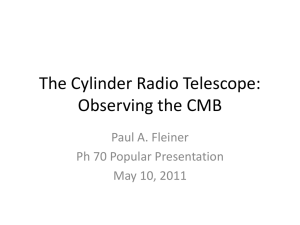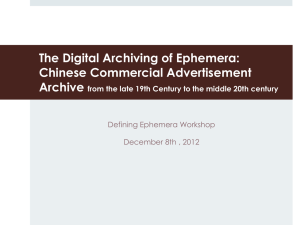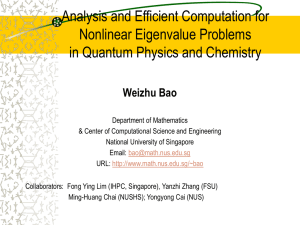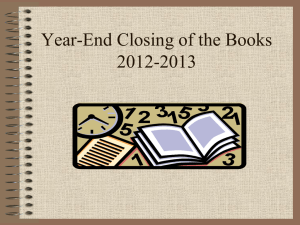proving acceleration and N_eff
advertisement
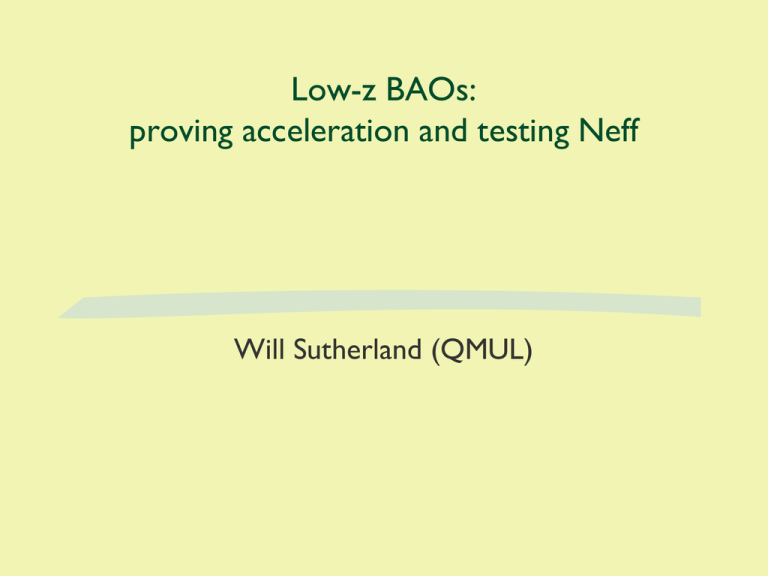
Low-z BAOs: proving acceleration and testing Neff Will Sutherland (QMUL) Talk overview Cases for low-redshift BAO surveys : 1. Smoking-gun test of cosmic acceleration - assumes only homogeneity & isotropy, not GR. 2. Testing fundamental assumptions from CMB era, in particular the number of neutrino species. 2005: first observation of predicted BAO feature by SDSS and 2dFGRS (Eisenstein et al 2005) BAO feature in BOSS DR9 data: ~ 6 sigma (Anderson et al 2012) BAO observables: transverse and radial Spherical average gives rs / DV , BAOs : strengths and weaknesses BAO length scale calibrated by the CMB . + Uses well-understood linear physics (unlike SNe). - CMB is very distant: hard to independently verify assumptions. BAO length scale is very large, ~ 153 Mpc: + Ruler is robust against non-linearity, details of galaxy formation + Observables very simple: galaxy redshifts and positions. - Huge volumes must be surveyed to get a precise measurement. - Can’t measure BAO scale at “ z ~ 0 ” + BAOs can probe both DA(z) and H(z); no differentiation needed for H(z). More sensitive to “features” in H(z); enables consistency tests for flatness, homogeneity. “Cosmic speed trap:” Proving cosmic acceleration with BAOs only Assuming homogeneity, evidence for accelerating expansion is strong: SNe, CMB+low-z measurements . SNe require acceleration independent of GR (if no evolution, and photon number conserved) CMB + LSS : acceleration evidence very strong, but requires assumption of GR. Possible loophole to allow non-accelerating model : Assume SNe are flawed by evolution and/or photon nonconserving processes (peculiar dust, photon/dark sector scattering). AND: GR not correct, so CMB inferences are misleading. This is contrived, but we should close this loophole Cosmic expansion rate: da/dt Cosmic expansion rate, relative to today BOSS: Busca et al 2012 Caveat: assumed flatness and standard rs Speed-trap: motivations Radial BAO scale directly measures rs H(z) / c Ratio of two such measurements will cancel rs , and detect acceleration directly. BUT, there is a practical problem: very feeble acceleration at z > 0.3 Not enough volume to measure radial BAOs at z < 0.3 . Can’t measure rs H0 at “z ~ 0”. Spherical-average BAOs can prove acceleration IF we assume almost-flatness, but we don’t want to rely on this. Workaround: use radial BAO at z ~ 0.7, compare to spherical-average BAO observable at z ~ 0.2 . Limit relating DV(z1) and H(z2) for any non-accelerating model: Comoving radial distance: No acceleration requires : therefore: Assuming homogeneity, angular-diameter distance is : No acceleration requires : Therefore : Open curvature: ()>1 Closed curvature : radial BAO observable: Spherical-average BAO observable, at z1 : Divide: Use previous limit for DV : Rearrange square-bracket onto LHS: now RHS becomes 1 + O(z2), depends very weakly on curvature. Define XS as “excess speed” , ratio of BAO observables: Flat models : RHS = 1 exactly . Open models : RHS < 1 … limit gets stronger. Closed models : RHS > 1 … need to constrain this. But, closed models have a maximum angular diameter distance < Rc / (1+z) , so z ~ 3 galaxy sizes eliminate “super-closed” models. (Sutherland, MN 2012, arXiv:1105.3838) Blue/green: predictions for LambdaCDM / wCDM Red: upper limits for non-accelerating model, various (extreme) curvatures. Speed-trap result: If we assume Homogeneity and isotropy Redshift due to cosmic expansion, and constant speed of light BAO length conserved in comoving coordinates No acceleration after redshift z2 Then : Observable BAO ratio must be below red-lines above If observed XS > 3 sigma above red-line , at least one of four statements above is false. “Signal” ~ 10 percent: need < 3% (ideally 2%) precision on ratio of two BAO observables. Challenging, but definitely achievable. Measuring the absolute scale of BAOs : BAO length scale is essentially the sound horizon at “drag redshift” zd ~ 1020. If we assume Standard GR Standard neutrino content Standard recombination history Nearly pure adiabatic fluctuations Negligible early dark energy Negligible variation in fundamental constants Then BAO length depends on just two numbers, ωm and ωb ; both well determined by WMAP and Planck. WMAP results give rs(zd) = 153 ± 2 Mpc (1.3 percent). Planck gives rs(zd) = 151.7 ± 0.5 Mpc (0.33 percent). Measuring the absolute scale of BAOs (2): Above assumptions are (mostly) testable from CMB acoustic peaks structure. But there’s a risk of circular argument… a wrong assumption may be “masked” by fitting biased values of cosmological parameters – especially H0 ; also Ωm, w etc. Highly desirable to actually measure the BAO length with a CMB-independent method. “Obvious” way: measure transverse BAOs and DL(z) at same redshift; distance duality gives DA(z) and absolute BAO scale. Would like to work at lower z , and use DV(z) Snag: DV(z) is not directly measurable with standard distance indicators. Effect of non-standard radiation density Definition of Neff : Matter density: Sound horizon in terms of rad. density and zeq : Define and use base parameter set : (WMAP7: Komatsu et al 2010) WMAP7 likelihood contours: Strong degeneracy between Neff and ωm ; but zeq is basically unaffected. WMAP7 likelihood contours: Not exact, but accurate summary : If we drop the assumption of standard Neff, then: WMAP still tells us redshift of matter-radiation equality ~ 3200, (Planck ~ 3350) , but the physical matter and radiation densities are much less precise. Keeping CMB acoustic angle constant requires physical dark energy density to scale in proportion to matter & radiation. best-fit inferred H0 scales as √(Xrad) Sound horizon rs scales as 1/ √(Xrad) . The BAO observables don’t change: inferred Ωm , w are nearly unbiased (Eisenstein & White 2004). If a 4th neutrino species, equivalent to 13.4% increase in densities, 6.5% increase in H (e.g. 70 to 74.5) and 6.1% reduction in cosmic distances/ages. Substantial effect ! Neff affects all dimensionful parameters : Nearly all our WMAP + SNe + BAO observables are actually dimensionless (apart from photon+baryon densities) : redshift of matter-radiation equality CMB acoustic angle SNe give us distance ratios or H0 DL /c . BAOs also give distance ratios. All these can give us robust values for Ω’s , w, E(z) etc ; almost independent of Neff . But: there are 3 dimensionful quantities in FRW cosmology ; Distances, times, densities. Two inter-relations : distance/time via c ,and Friedmann equation relates density + timescale, via G. This leaves one short, i.e. any number of dimensionless distance ratios can’t determine overall scale. Usually, scales are (implicitly) anchored to the standard radiation density, Neff ~ 3.04 . But if we drop this, then there is one overall unknown scale factor. Neff , continued… Photon and baryon densities are determined in absolute units… but these don’t appear separately in Friedmann eq., only as partial sums. Rescaling total radiation, total matter and dark energy densities by a common factor leaves WMAP, BAO and SNe observables (almost) unchanged; but changes dimensionful quantities e.g. H. Potential source of confusion: use of h and ω’s. These are unitless but they are not really dimensionless, since they involve arbitrary choice of H = 100 km/s/Mpc , and corresponding density. What BAOs really measure : Standard rule-of-thumb is “CMB measures ωm , and the sound horizon; then BAOs measure h ” : only true assuming standard radiation density. Really, CMB measures zeq ; adding a low-redshift BAO ratio measures (almost) Ωm. These two tell us H0 / √(Xrad) , but not an absolute scale. Thus, measuring the absolute BAO length provides a strong test of standard early-universe cosmology, especially the radiation content (Neff). Measuring just H0 is less good, since it mixes Neff, w and curvature. The absolute BAO scale probes only the early universe. Measuring the absolute BAO scale (3) : Need two observations: a relative BAO ratio at some redshift, and an absolute distance measurement to a matching redshift. It is generally easier to measure cosmic distances at lower z ~ 0.25, which favours BAOs at moderate redshift. For SNe, the issue is evolution, so shorter time lever arm is favourable. SNe are better in near-IR (Barone-Nugent et al 2012); sweet spot at z~0.3 where rest-frame J, H appear in observed H,K. For lens time delays, degeneracy with cosmology: zl << zs is favourable for absolute distances. The “ideal” distance indicators long-term may be gravitational wave standard sirens; precision limited by SNR , favours lower z. It is feasible to reach 1.5% precision on BAO ratio at z ~ 0.25 ; this is probably better than medium-term distance indicators. Measuring the absolute scale of BAOs (4): Most robust quantity from a BAO survey is rs / DV(z) ; this is (almost) theory-independent. DV is related to comoving volume per unit redshift… Could measure DV exactly if we had a population of “standard counters” of known comoving number density. But prospects don’t look good – galaxy evolution. At very low z, DV ≈ c z / H0 . But error is 6% at z ~ 0.2 : much too inaccurate. Next we’ll find much better approximations for DV(z)… Pretty good approximations (< 0.5 percent at z < 0.4): Suitable choice of z’s can eliminate H and gives : Relative accuracy of approximation : 1 percent Relative accuracy of approximation : 1 percent Better approximation: 1 percent Accuracy < 0.2 percent at z < 0.5 An easy route to Ωm h becomes a derived parameter: Define ε as error in approximation : BAO ratio is : This is exact (apart from non-linear shifts in rs ) and fully dimensionless: all H and ω’s cancelled. An easy route to Ωm For WMAP baryon density, the above simplifies to the following , to 0.4 percent : This is all dimensionless, and nicely splits z-dependent effects: • Zeroth-order term is just Ωm-0.5 (strictly Ωcb , without neutrinos) • Leading order z-dependence is E(2z/3) • The εV is second-order in z, usually ~ z2 / 25 and almost negligible at z < 0.5 An easy route to Ωm Repeat approximation from previous slide : Substituting in the WMAP range for zeq , and the BAO measurement at z = 0.35 from Padmanabhan et al (2012), and discarding the sub-percent εV , this gives And just square and rearrange to : Why DV approximation is good: post-hoc explanation using Taylor series Deceleration and Jerk parameters: For “reasonable” models, abs [ ] < 4 … leading order error < z2 / 27 Conclusions : BAOs are a gold standard for cosmological standard rulers. Very well understood; observations huge in scope but clean. Most planned BAO surveys are targeting z > 0.7, to exploit the huge available volume and sensitivity to dark energy w. However, there are still two good cases for optimal low-z BAO surveys at z ~ 0.25 (e.g. extending BOSS to South and lower galactic latitude) : A third direct test of cosmic acceleration, without GR assumption. (arXiv:1105.3838) In conjunction with precision distance measurements, can provide a test of the CMB prediction rs ~ 151 Mpc, and/or a clean test for extra “dark radiation”, independent of DE and curvature. (arXiv:1205.0715) Thank you !

